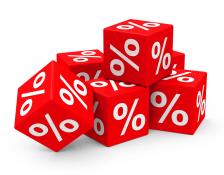3 Tips for Calculating Percentages
How quickly can you calculate 25% of 70? Or 40% of 50? Or 75% of 160? Keep on reading to learn three easy tips for calculating percentages.

This means it pays (at times literally) to understand both what percentages mean and how to calculate them. And it also pays to be able to calculate them quickly. How can you learn to do so? Practice, of course. Plus a bit of know-how never hurts, which is exactly what you’ll be picking up today as we take a look at three easy tips to help boost your percentage calculating skills.
Recap: The Meaning of Percent
Before we get too deep into tricks for calculating percentages, let’s take a minute to remind ourselves of what these little beasties are all about. The meaning of percentage is right there in the word: percent = per cent. In other words, something like 25 percent means “25 per cent” or “25 per 100” (think about the fact that there are 100 cents in a U.S. dollar to see why the “cent” in percent implies 100).
A forecasted 25% probability of rain on some day therefore means that it will rain 25 out of every 100 days that are exactly like it. Alternatively, it means that if the universe could somehow run that day over and over again 100 times, you’d expect that everything would come together to produce rain 25 out of those 100 times—that’s 25% of the time.
Tip #1: Divide Instead of Multiply
With that understanding, let’s now dive into some quick tricks for calculating percentages. First up, when asked to find something like 25% of 60, most people will start by converting 25% into the decimal 0.25, and will then multiply this by 60. So 25% of 60 = 0.25 x 60. (If you’re not sure about any of this, you might want to check out some of the other Math Dude articles on percentages before continuing on).
See if you might be able to divide your way to a solution to percentage problems instead.
But this way of doing things is actually a lot more work than you need to do. The conversion from a percentage into a decimal is easy, but multiplying by decimals is a pain…don’t you think? So today’s first tip is that instead of immediately resorting to converting to a decimal and then multiplying as we’ve done, you should always think for few seconds and see if you might be able to divide your way to a solution to percentage problems instead.
What do I mean by this? Well, when it comes to solving problems 25% has the same meaning as the decimal 0.25. But the decimal 0.25 has the same meaning as the faction 1/4. So instead of multiplying 60 by the decimal 0.25 (which is a pain), all we really have to do is divide 60 by 4 (which is easy) to find that 25% of 60 is equal to 60 / 4 = 15. I don’t know about you, but I’ll always take a simple division problem like this over the more complicated decimal multiplication problem—especially when I’m trying to do it in my head!
Tip #2: Divide and Then Multiply
Today’s second tip is a close cousin of the first. In fact, it’s the exact same idea just used in a slightly more complicated situation. For example, let’s say we’re trying to find 40% of 50. As always, one way to tackle this problem would be to convert 40% into the decimal 0.4 and then to proceed with the multiplication: 0.4 x 50.
But, as before, I’d rather not do that decimal multiplication—call me lazy if you want. Instead, I’d prefer to use the fact that 40% (being equivalent to the decimal 0.4) is really the same as the fraction 4/10 or, after reducing the fraction, 2/5. Just as we did for the first tip, I can use this to solve the problem by dividing by an integer instead of multiplying by a decimal. For the simple fraction with a 1 in the numerator that we saw in the first tip, this was the end of the story. But this time around the fraction isn’t so simple—it has a 2 in its numerator. But that just means that we have to finish things off with a bit of simple integer multiplication. When we put this all together, we find that 40% of 50 = 50 x (2/5) = 2 x (50 / 5) = 2 x 10 = 20.
This might seem like a lot to keep track of right now, but once you get used to it you’ll see that this way of thinking about things makes solving problems in your head much easier.
Tip #3: Sometimes It’s Best to Subtract
Just to keep things in the family, today’s third and final tip is yet another cousin to the first tip (and by extension to the second). This time, the tip is that when dealing with percentage calculations, it’s sometimes wise to throw a bit of subtraction into the mix. To see what I mean, let’s look at the problem of calculating 75% of 160.
When dealing with percentage calculations, it’s sometimes wise to throw a bit of subtraction into the mix.
If you’ve got the gist of the first tip, you’ll realize that 75% is equivalent to the fraction 3/4. And you’ll realize that you could solve this problem by first dividing 160 by 4 and then by multiplying the result by 3. While that’s actually not too tough in this problem, there is still an easier (and quicker) way. The trick is to realize that 75% is 25% less than 100%. Since 25% is equivalent to the fraction 1/4, we can very quickly use the first tip to find that 25% of 160 is equal to 40 (since 160 / 4 = 40). And since 75% is equal to 100% – 25%, we can also very quickly find that 75% of 160 must be equal to 100% of 160 minus 25% of 160, or 160 – 40 = 120.
Of course, any way you choose to do these problems and get the correct answer is perfectly fine. It’s just that sometimes one way is quicker (and perhaps less error prone) than another. The real trick is for you to take all of the possibilities in, to think about them and understand what they mean, to practice using them in everyday life, and then to figure out for yourself which method works best for you in different situations. Once you’ve done that, you’re well on your way to mastering the fine art of calculating percentages.
Wrap Up
OK, that’s all the math we have time for today.
For more fun with math, please check out my book, The Math Dude’s Quick and Dirty Guide to Algebra. And remember to become a fan of The Math Dude on Facebook, where you’ll find lots of great math posted throughout the week. If you’re on Twitter, please follow me there, too.
Until next time, this is Jason Marshall with The Math Dude’s Quick and Dirty Tips to Make Math Easier. Thanks for reading, math fans!
Percentage image from Shutterstock.
You May Also Like…






